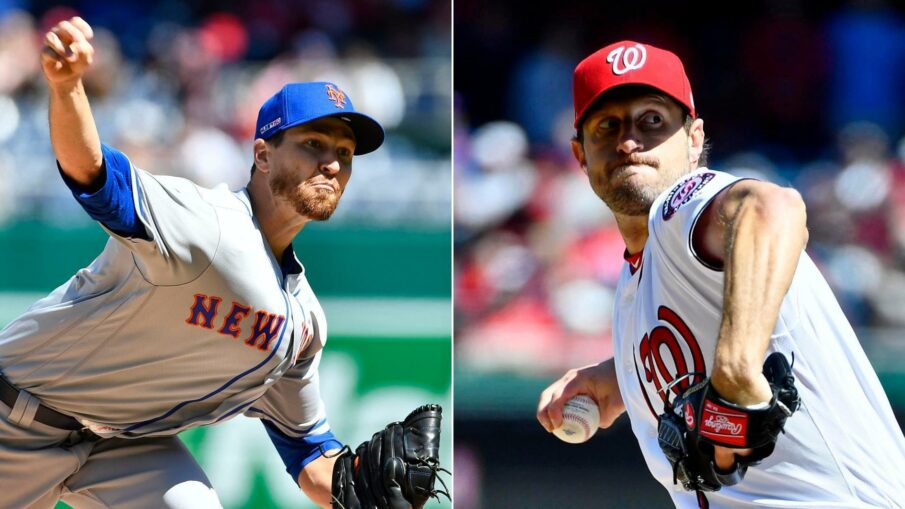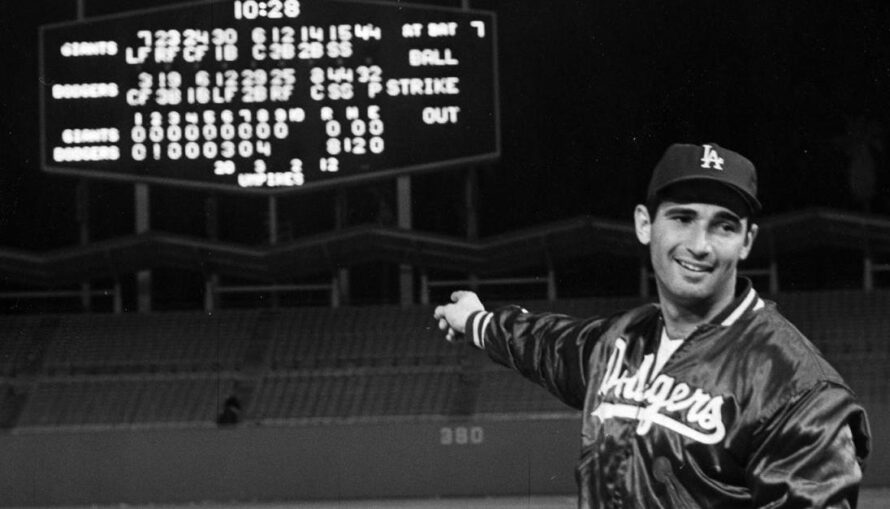
Jacob deGrom seems poised to win his second consecutive Cy Young Award after another outstanding season. If he does, that would make him only the 11th pitcher in history to win back-to-back awards.
While Tom Seaver won the award three times (1969, 1973, 1975), he never won in back-to-back seasons. Between Tom Seaver and Jacob deGrom came only Dwight Gooden and R.A. Dickey, rounding out the group of pitchers who won the Cy Young while pitching in Queens.
In 2018, deGrom went 10-9 with an MLB-leading 1.70 ERA, 1.98 FIP, 218 ERA+, and 0.4 HR/9. He also boasted 269 strikeouts in 217 innings as well as a 0.912 WHIP and 9.6 bWAR, and would have likely been unanimous if it weren’t for a lone voter from San Diego who values wins above all else. He followed up that historic season with an 11-8 record, striking out an NL-leading 255 batters in 204 innings while registering a 2.43 ERA, 2.67 FIP, 167 ERA+, 0.971 WHIP, and 7.3 bWAR. Overall, in those two seasons, he went 21-17 with a 2.05 ERA, 2.32 FIP, 189 ERA+, 0.941 WHIP, and 11.2 K/9.
Overall, should deGrom win, he would cement these two seasons and two of the best consecutive seasons of all time. Here, we will take a look at the ten pitchers who have won the Award in back-to-back seasons, starting with the most recent. Let’s see how deGrom stacks up against them.
Max Scherzer (2016, 2017)
If deGrom does not win the 2019 NL Cy Young, it would almost certainly be because of Scherzer. Either way, only people named Scherzer or deGrom will have won the award since 2016.
In 2016, Scherzer won the first of two consecutive (but three overall) Awards after going 20-7 with a 2.96 ERA, 3.24 FIP, 144 ERA+, MLB-leading 0.968 WHIP, and 6.3 bWAR. He struck out an MLB-leading 284 batters in 228 1/3 innings across his 34 starts, garnering 25 of 30 first-place votes for the award.
He followed up that strong season with an even better one, albeit one shortened slightly by a minor injury. Making only 31 starts, Scherzer went 16-6 with a 2.51 ERA, 2.90 FIP, 178 ERA+, 0.902 WHIP, and 7.2 bWAR. He struck out an NL-leading 268 batters in 200 2/3 innings, good for a 12.0 K/9 which was better than his 11.2 mark from 2016. He earned 27 of 30 first-place votes.
Overall in two seasons, Scherzer went 36-13 with a 2.75 ERA, 3.08 FIP, 159 ERA+, 0.937 WHIP, and 11.6 K/9. His 2018 season blew both of those Cy Young-winning years out of the water, but he was still not close to deGrom.

Clayton Kershaw (2013, 2014)
We often forget how unbelievably good Clayton Kershaw was for a long time, even though he’s still pitching and only 31 years old. He won his second Cy Young Award in 2013 after going 16-9 with an MLB-leading 1.83 ERA, 2.39 FIP, MLB-leading 0.915 WHIP, MLB-leading 194 ERA+, and 8.0 bWAR. He struck out 232 batters in 236 innings, tossing two shutouts. He garnered 29 of 30 first-place votes, with one out-of-touch voter choosing Adam Wainwright simply because he won three more games.
Kershaw followed up his second career Cy Young with a third, as he went 21-3 in 2014 despite starting only 27 games. Each of the following numbers led all of the MLB that season: 1.77 ERA, 1.81 FIP, 197 ERA+, 0.857 WHIP, 10.8 K/9, six shutouts, and a 7.7 bWAR. He struck out 239 batters in 198 1/3 innings en route to not only a unanimous Cy Young win, but NL MVP honors as well.
Overall across those two seasons, he went 37-12 with a 1.80 ERA, 2.12 FIP, 196 ERA+, 0.889 WHIP, and 9.8 K/9. These two seasons are definitely toward the top of the list in terms of back-to-back seasons ever for a starting pitcher.
Tim Lincecum (2008, 2009)
The only pitcher ever to win the Cy Young in his first two full seasons, Tim Lincecum and his funky mechanics made history. He started in 2008 when he went 18-5 with a 2.62 ERA, MLB-leading 2.62 FIP, MLB-leading 168 ERA+, 1.172 WHIP, and 7.8 bWAR. He led the MLB with 265 strikeouts in 227 innings, garnering 23 of 30 first-place votes.
He pitched even better in 2009, going 15-7 with a 2.48 ERA, 2.34 FIP, 171 ERA+, 1.047 WHIP, and 7.4 bWAR. He led the National League with 261 strikeouts in 225 1/3 innings, earning just 11 first-place votes. In fact, Adam Wainwright garnered 12 first-place votes but finished third overall, with teammate Chris Carpenter earning nine first-place votes and finishing second.
Overall across those two seasons, Lincecum went 33-12 with a 2.55 ERA, 2.48 FIP, 170 ERA+, 1.110 WHIP, and 10.5 K/9. His last All-Star-caliber season was 2011, enduring a pretty steep decline after that. He has not pitched in a Major League game since 2016.
Randy Johnson (1999, 2000, 2001, 2002)
One of two pitchers in history to win four straight Cy Young Awards, Randy Johnson was 6’10” of winning pitcher for the Diamondbacks from 1999 to 2004, winning four straight Cy Young Awards from 1999-2002 and finishing second in voting in 2004. To make it easier for both of us, here are his numbers for those four seasons. Any numbers in bold means he led the National League and bold/italics means he led MLB.
1999: 17-9, 2.48 ERA, 2.76 FIP, 184 ERA+, 1.020 WHIP, 271.2 IP, 364 K, 12.1 K/9, 12 CG, 2 SHO, 9.1 bWAR
2000: 19-7, 2.64 ERA, 2.53 FIP, 181 ERA+, 1.118 WHIP, 248.2 IP, 347 K, 12.6 K/9, 8 CG, 3 SHO, 8.1 bWAR
2001: 21-6, 2.49 ERA, 2.13 FIP, 188 ERA+, 1.009 WHIP, 249.2 IP, 372 K, 13.4 K/9, 3 CG, 2 SHO, 10.1 bWAR
2002: 24-5, 2.32 ERA, 2.66 FIP, 195 ERA+, 1.031 WHIP, 260.0 IP, 334 K, 11.6 K.9, 8 CG, 4 SHO, 10.7 bWAR
The Big Unit is one of the best pitchers of all time, and during those four seasons, he was one of – if not the best – in the game. His 2001 and 2002 seasons were his best, so let’s combine those two: 45-11, 2.40 ERA, 2.40 FIP, 192 ERA+, 1.020 WHIP, 12.5 K/9. Add in his World Series MVP Award in 2001 and those two seasons are tough to beat.

Pedro Martinez (1999, 2000)
If you look at Randy Johnson‘s above numbers in 1999 and 2000, the ones that he led the league with, but not the MLB, are probably because of this guy. Pitching for the Red Sox in 1999, Pedro went 23-4 with an MLB-best 2.07 ERA, Modern Era-best 1.39 FIP, 243 ERA+, 0.923 WHIP, and 9.8 bWAR. He struck out 313 batters in 213 1/3 innings, good for an MLB-best 13.2 K/9 and also registering an amazing 8.46 K/BB ratio (MLB-best). He won 23 games despite making only 29 starts, which is amazing. But the most amazing number is his 1.39 FIP (not a typo), the best for a pitcher by far since 1910. The only other pitcher to record a FIP under 1.75 since 1910 was Dwight Gooden in 1984 – his rookie season.
He followed up his historic season with another, going 18-6 with an MLB-best 1.74 ERA, MLB-best 2.17 FIP, Modern Era-best 29 ERA+, and best-ever 0.737 WHIP. Yeah. He also struck out 284 batters in 217.0 innings while walking only 32, good for 11.8 K/9 and 8.88 K/BB ratios, as well as an 11.7 overall bWAR. Needless to say, he was the unanimous choice for AL Cy Young in both seasons.
Combined, Pedro went 41-10 with a 1.90 ERA, 1.79 FIP, 265 ERA+, 0.830 WHIP, and 12.5 K/9.
Greg Maddux (1992, 1993, 1994, 1995)
Randy Johnson‘s partner-in-crime as the only two pitchers to win four-straight Cy Young Awards, Greg Maddux has one of the best resumes of any pitcher ever. Winning his first Cy Young in 1992 for the Cubs and the remaining three for the Braves, Maddux could throw a baseball wherever he wanted, whenever he wanted. Here are his numbers for those four seasons:
1992: 20-11, 2.18 ERA, 2.58 FIP, 166 ERA+, 1.011 WHIP, 268.0 IP, 199 K, 9 CG, 4 SHO, 9.1 bWAR
1993: 20-10, 2.36 ERA, 2.85 FIP, 170 ERA+, 1.049 WHIP, 267.0 IP, 197 K, 8 CG, 1 SHO, 5.8 bWAR
1994*: 16-6, 1.56 ERA, 2.39 FIP, 271 ERA+, 0.896 WHIP, 202.0 IP, 156 K, 10 CG, 3 SHO, 8.5 bWAR
1995: 19-2, 1.63 ERA, 2.26 FIP, 260 ERA+, 0.811 WHIP, 209.2 IP, 181 K, 10 CG, 3 SHO, 9.7 bWAR
After starting 71 games between 1992 and 1993, reasons including the 1994 strike limited him to only 53 starts between 1994 and 1995. Quality outweighs quantity in this case, however, as his last two Cy Young seasons rank as some of the best all-time. Combined, he went 35-8 with a 1.60 ERA, 2.32 FIP, 265 ERA+, 0.853 WHIP, and 6.24 K/BB ratio.
*Roger Clemens (1986, 1987 – 1997, 1998)
1986: 24-4, 2.48 ERA, 2.81 FIP, 169 ERA+, 0.969 WHIP, 254.0 IP, 238 K, 10 CG, 1 SHO, 8.8 bWAR
1987: 20-9, 2.97 ERA, 2.91 FIP, 154 ERA+, 1.175 WHIP, 281.2 IP, 256 K, 18 CG, 7 SHO, 9.4 bWAR
1997: 21-7, 2.05 ERA, 2.25 FIP, 222 ERA+, 1.030 WHIP, 264.0 IP, 292 K, 9 CG, 3 SHO, 11.9 bWAR
1998: 20-6, 2.65 ERA, 2.65 FIP, 174 ERA+, 1.095 WHIP, 234.2 IP, 271 K, 5 CG, 3 SHO, 5.9 bWAR
Those numbers would be impressive, but he cheated, so they don’t mean much.
Jim Palmer (1975, 1976)
One of the more underrated pitchers in history, Jim Palmer dominated opposing hitters for a long time, but especially in 1975 and 1976. His best season was easily in 1975, when he went 23-11 with an MLB-leading 2.09 ERA, 2.96 FIP, MLB-best 169 ERA+, 1.031 WHIP, and 8.4 bWAR. Not known for strikeouts, he fanned 193 batters in 323 innings across 38 starts including 10 complete games.
1976 saw Palmer go 22-13 with a 2.51 ERA, 3.33 FIP, 130 ERA+, 1.076 WHIP, and 6.5 bWAR in 315 innings across 40 starts. Combined, Palmer went 45-24 in 1975 and 1976, recording a 2.30 ERA, 3.14 FIP, 148 ERA+, 1.053 WHIP, and 2.15 K/BB ratio. He would have won three straight Cy Youngs, but he finished second in voting to closer Sparky Lyle in 1977.

Denny McLain (1968, 1969)
The last pitcher to win more than 30 games in a season, Denny McLain shocked the baseball world in 1968 by going 31-6 with a 1.96 ERA, 2.53 FIP, 154 ERA+, 0.905 WHIP, and 7.4 bWAR. He struck out 280 batters in 336 innings across 41 starts, throwing an amazing 28 complete games. He was the unanimous choice for both the AL Cy Young and MVP Awards, while Bob Gibson and his 1.12 ERA won both NL Awards. In a battle of the best, the Tigers would beat the Cardinals in the 1968 World Series.
McLain saw continued success in 1969, as we went 24-9 with a 2.80 ERA, 3.05 FIP, 134 ERA+, 1.092 WHIP, and 8.1 bWAR. He struck out 181 batters in 325 innings across 41 starts, throwing 23 complete games and an MLB-leading nine shutouts. Combining both seasons, McClain went 55-15 which is the highest win total of this group, barely edging out Koufax. In 82 starts, McLain had a 2.37 ERA, 2.79 FIP, 142 ERA+, 0.997 WHIP, and 3.55 K/BB ratio.
Sandy Koufax (1965, 1966)
If you don’t know the legend of Sandy Koufax, allow me to enlighten you. These two seasons in which he won back-to-back Cy Young awards were his last seasons, as he announced his retirement at the age of 30. Having hurt his arm in 1964, Koufax pitched through immense pain during the subsequent seasons having torn muscles in his arm and damaging his elbow cartilage. During 1965 and 1966, he pitched through unmatchable pain that could have been remedied by the yet-to-be-invented laparoscopic surgery. Keeping that in mind, here are his numbers for those two seasons:
In 1965, Koufax went 26-8 with a 2.04 ERA, 1.93 FIP, 160 ERA+, 0.855 WHIP, and an 8.1 bWAR. He struck out 382 batters, a record that would stand until Nolan Ryan struck out 383 in 1973, and walked only 71 in 335 2/3 innings. His wins, ERA, FIP, WHIP, 5.8 H/9, and 5.38 K/BB were all MLB bests that season as we unanimously won the ML Cy Young (there were not yet separate AL and NL Awards). He also threw the one and only Perfect Game in Dodgers’ history (his fourth no-hitter).
In 1966, his last season, we saw The Left Arm Of God go 27-9 with an MLB-leading 1.73 ERA, MLB-leading 2.07 FIP, MLB-leading 190 ERA+, 0.985 WHIP, and 10.3 bWAR. He struck out 317 batters in 323 innings, both MLB bests. He threw 27 complete games in both ’65 and ’66, tossing eight shutouts in ’65 and leading the MLB with five in ’66.
Combined, he went 53-17 with a 1.89 ERA, 2.00 FIP, 174 ERA+, 0.919 WHIP, 9.6 K/9, and 4.72 K/BB.
How does deGrom stack up?
Well, I’d say that’s up to you. His sub-2.00 ERA and FIP as well as 219 ERA+ from 2018 certainly cement that as one of the best seasons ever, let alone on this list. His 2019 season, while not as sparkling, is still very very good and far from the bottom of seasons on this list as well.
Only two pitchers, Randy Johnson and Greg Maddux, have won three consecutive Cy Youngs. Jacob deGrom shows no signs of slowing down, so if he does win the 2020 Cy Young as well, his company will diminish for the best reason.













